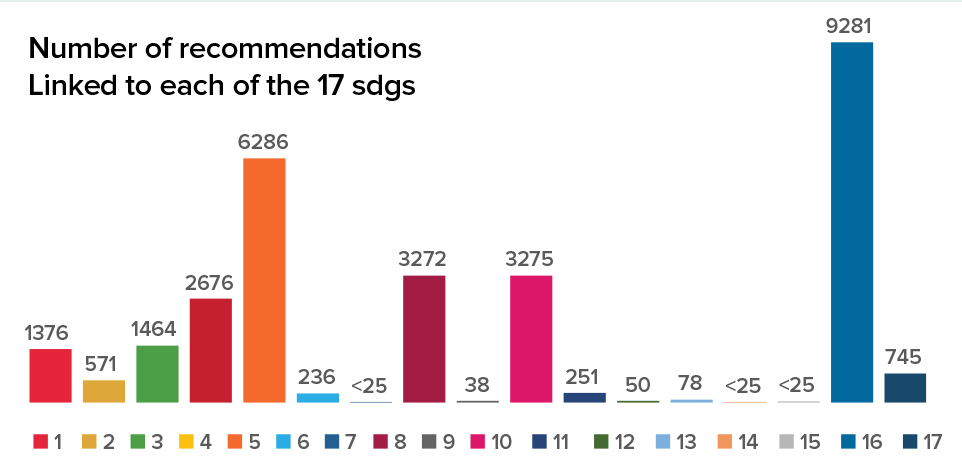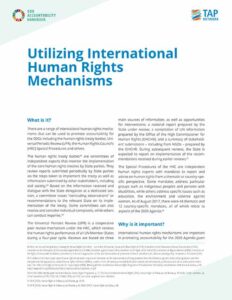Utilizing International Human Rights Mechanisms
What is it?
There are a range of international human rights mechanisms that can be used to promote accountability for the SDGs including the human rights treaty bodies, Universal Periodic Review (UPR), the Human Rights Council’s (HRC) Special Procedures and others.
The human rights treaty bodies1 are committees of independent experts that monitor the implementation of the core human rights treaties by State parties. They review reports submitted periodically by State parties on the steps taken to implement the treaty as well as information submitted by other stakeholders, including civil society.2 Based on the information received and dialogue with the State delegation at a dedicated session, a committee issues “concluding observations” or recommendations to the relevant State on its implementation of the treaty. Some committees can also receive and consider individual complaints, while others can conduct inquiries.3
The Universal Periodic Review (UPR) is a cooperative peer review mechanism under the HRC, which reviews the human rights performance of all UN Member States during a four-year cycle. Reviews are based on three main sources of information, as well as opportunities for interventions: a national report prepared by the State under review; a compilation of UN information prepared by the Office of the High Commissioner for Human Rights (OHCHR); and a summary of stakeholders’ submissions – including from NGOs – prepared by the OHCHR. During subsequent reviews, the State is expected to report on implementation of the recommendations received during earlier reviews.4
The Special Procedures of the HRC are independent human rights experts with mandates to report and advise on human rights from a thematic or country-specific perspective. Some mandates address particular groups such as Indigenous peoples and persons with disabilities, while others address specific issues such as education, the environment and violence against women. As of August 2017, there were 44 thematic and 12 country-specific mandates, all of which relate to aspects of the 2030 Agenda.5
Why is it important?
International human rights mechanisms are important in promoting accountability for the 2030 Agenda given the significant overlap between the SDGs and human rights standards. More than 90 per cent of the 169 SDG targets reflect core international human rights standards.7 Further, unlike the SDGs, these international standards are legally binding.
Given that States are already subject to reporting obligations, existing human rights mechanisms can be used to raise human rights issues in the context of the SDGs. In reviewing countries, monitoring bodies can comment on and make recommendations to further SDG implementation including in relation to the discrimination or exclusion of specific groups, gaps in policy and legal frameworks, and the generation, allocation and use of resources necessary for the fulfilment of human rights that coincide with the SDGs.8 Importantly, monitoring bodies can assess progress on the SDGs that overlap with human rights, as well as whether plans, processes and outcomes of SDG implementation respect, protect and fulfil human rights.9
The wealth of analysis, data, information and recommendations produced by existing human rights and labour mechanisms can also be used to inform SDG-specific accountability processes and reports including Voluntary National Reviews (VNRs). In line with the 2030 Agenda, which states that “data and information from existing reporting mechanisms should be used where possible,”10 States and other actors – including civil society – can use existing human rights information to measure and assess implementation and progress towards achieving the SDGs for specific countries, topics or vulnerable groups.
TIP
Linking the UPR to the SDG
Over the two cycles of the Universal Periodic Review (UPR), more than 50,000 recommendations have been issued by states. Using an innovative and experimental data mining procedure, the Danish Institute for Human Rights (DIHR) has so far been possible to link more than 50% of these to specific SDG targets. The below chart illustrates how recommendations are linked across the 17 goals.

How can it be used?
CSOs may use international human rights standards to promote accountability for the 2030 Agenda in the following ways:
1. Engage with human rights mechanisms and forums to raise SDG-related issues – CSOs can participate in human rights reporting processes in order to bring attention to SDG issues that overlap with human rights and labour standards. In particular, CSOs should:
a. Determine which mechanism to engage with by analysing the links between the SDGs and a country’s human rights and labour standards. CSOs can use the Human Rights Guide to the SDGs, the UPR-SDG Data Explorer and/or the Universal Human Rights Index to identify links between human rights and labour standards with the SDGs;
b. Familiarize yourself with the specific rules, modalities and timelines for civil society interaction with the human rights body(s) or process with which you wish to engage. The OHCHR has a Handbook for Civil Society that provides a useful overview.
c. Participate in consultations held by governments to prepare their national report on the human rights situation in their country and/or consultations held by independent human rights experts under the Special Procedures of the HRC;
d. Prepare written submissions on the human rights situation in the country in relation to the SDGs for consideration by human rights bodies. Many of the human rights treaty bodies accept written information, materials and reports from civil society, while the UPR process accepts written submissions from stakeholders for potential inclusion in a summary of stakeholders’ submissions prepared by the OHCHR.
e. Produce civil society shadow reports on the human rights situation in relation to the SDGs. [For information on drafting reports, see chapter on civil society reporting.]
f. Participate in human rights review sessions as observers and/or through oral submissions. Depending on the rules of the human rights body, CSOs may be able to attend reviews and/or offer oral submissions or brief general comments on the SDGs at review sessions or pre-sessional working groups held by human rights bodies.12
g. Follow-up on the outcomes of reviews by engaging with governments to help them meet their joint human rights and SDG obligations. The outcomes of human rights reviews can be a basis for dialogue with governments to further the implementation of the SDGs and human rights standards. Concluding observations or recommendations can also be used to raise awareness about the government’s SDG and human rights obligations among civil society and citizens. [See chapter on awareness-raising.]
2. Use information from human rights reporting mechanisms to inform SDG reviews – CSOs can also use information, reports and recommendations from human rights and labour mechanisms to inform SDG-specific accountability processes such as Voluntary National Reviews (VNRs). Notably, the Handbook for the Preparation of Voluntary National Reviews encourages countries to draw on existing human rights reports when drafting their VNR report.13
The Danish Institute for Human Rights provides a helpful step-by-step guide on how to use human rights reporting in VNRs that may also be useful to CSOs wishing to use human rights information to inform SDG review processes at national and/or subnational levels.
You can find a step-by-step guide and other resources to help examine the interlinkages between human rights and the SDGs through DIHR’s “Human Rights Guide to the SDGs”.
Key Resources
• The Human Rights Guide to the SDGs, by the Danish Institute for Human Rights, is an online database – available in 7 languages – that allows users to identify the links between SDGs and international and regional human rights instruments, labour standards and key environmental instruments.
• The UPR-SDG Data Explorer, by the Danish Institute for Human Rights, is an online database that allows users to explore how UPR recommendations for specific countries, regions or groups of rights-holders are linked to the SDGs.
• OHCHR’s Universal Human Rights Index – available in the 6 official languages of the UN – allows searches of Observations and Recommendations of all UN treaty bodies, Special Procedures and the Universal Periodic Review (UPR). The index is searchable in relation to key rights or groups of rights, countries and regions, as well as specific types of populations or population groups.
• The OHCHR’s website provides information and documentation relating to a range of human rights bodies including the treaty-based bodies and charter-based bodies that oversee mechanisms such as the UPR.
• Working with the United Nations Human Rights Programme: A Handbook for Civil Society (2008), by the OHCHR is a practical guide on how civil society can engage with and contribute to UN human rights bodies and mechanisms.
• NORMLEX, the ILO’s Information System on International Labour Standards, provides all comments and recommendations of the CEACR.
• The OHCHR’s Civil Society Unit is dedicated to strengthening engagement between civil society and the UN human rights programme and provides information on a broad range of issues.
• UPR Info is a Geneva-based NGO that aims to raise awareness of the UPR and supports the effective and meaningful participation of civil society in the UPR process.
Case Study: Providing Input into International Monitoring Processes to Advocate for National Reforms
Rwanda: Despite constitutional guarantees for the right to freedom of speech and the media in Rwanda, there remain gaps in legislation and policy to protect these rights. As part of its response to this problem, the Human Rights First Rwanda Association (HRFRA) engaged with the Ministry of Justice to provide input into Rwanda’s Universal Periodic Review (UPR) report, drawing attention to the challenges of access to information, freedom of expression and access to justice. HRFRA was active in identifying which ministry was responsible for the UPR process and engaging with the unit responsible for putting together the report. Using evidence-based research, HRFRA provided technical inputs to the report. HRFRA undertook its own legal analysis of existing legislation on media freedom and access to information and incorporated relevant report findings from bodies such as the Rwanda Media Commission. As a result of HRFRA’s lobbying, one of the key recommendations from the HRC following the 2011 UPR process called for better protections of the rights to freedom of expression, the media and access to information. HRFRA used this as the basis for their advocacy, engaging in open dialogue with the government on how to take this recommendation forward. Subsequently, Parliament passed Law N°02/2013, which removed certain restrictions on the press in Rwanda, and Law N°04/2013, which gave every person the right to information in the possession of public, and some private, bodies. Subsequently, HRFRA, in partnership with Africa Freedom of Information Network, provided input into the second UPR process, producing a parallel report for Rwanda in 2015 that updated the HRC on progress on freedom of expression and information, as well as highlighted ongoing challenges with implementation.14


